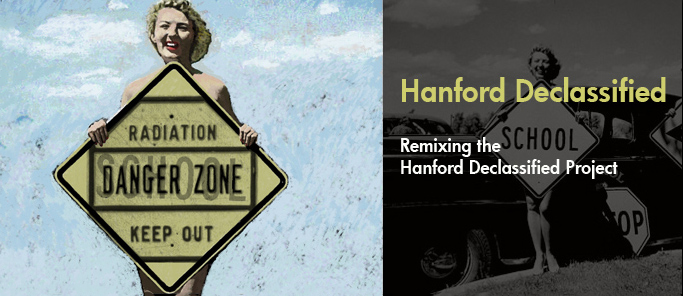Remixing the Hanford
Declassified Project
a web project by Juli Kearns
The plutonium for FAT MAN, the bomb that ruthlessly devastated Nagasaki, was manufactured for the Manhattan Project at the Hanford Nuclear Reserve in the state of Washington. Richland, the town the bomb built, afterward promoted itself as the Atomic Frontier, a kind of Ground Zero of Cold War Culture. The WWII workers didn't know what they were making. The townspeople envisioned themselves super modern pioneers. In this case, the legacy of "hindsight is 20/20" is the most toxic site in the western hemisphere, a threat to the health of the pacific northwest.
That the plutonium dropped on Nagasaki was made at Hanford in southeastern Washington State, or that Hanford is said by some to be the most toxic site in the western hemisphere, and one of the most polluted sites in the world, is still, I don't believe, known by many. One hears a lot about Los Alamos but not so much about Hanford, though leaking tanks have contaminated the groundwater and created a plume that will eventually reach the Columbia River if not contained.
I grew up in Richland, a town that was built by the Manhattan Project to house workers at Hanford and which remains so proud of its heritage that the mascot of the Richland high school is a bomb, the students are known as The Bombers and the emblem of the school is a mushroom cloud.
My father was a scientist at Hanford in the 50s and 60s, studying the effects of low level radiation on miniature livestock and when I was nine years of age I was one of the many school children in Richland who took part in a very casually portrayed testing on the possible transmission of low level radiation through local dairy and food.
When I learned of the Hanford Declassification Project that made available nearly 77,000 photographs and other documents, I was greatly interested.
The archive further captured my imagination when a search for the words "Nagasaki" and "Hiroshima" yielded no results. It was curious to me that Nagasaki and Hiroshima had been excised so neatly from the declassified documents for this portion of the Manhattan Project, which made me wonder what I could find using keywords one wouldn't associate with the bomb--such as dancers. Thus was initiated my own ongoing project of taking the photos and using them as base for digital paintings and collages, attempting to examine cultural context and--with the images and commentary--make a bridge between Hanford/Richland and Nagasaki, between the atomic era then and nearly three-quarters of a century on.
The Remixing the Hanford Declassified Project resulted in 41 time-intensive images, mostly digital paintings, based on photos painstakingly culled from the Hanford Declassification site, and a total of about 60 interpretive/commentary posts on the subject, the bulk of which were made from from 2005 to 2007, but with some past that, up to 2013.
Continue to the "Remixing the Hanford Declassified Project"

